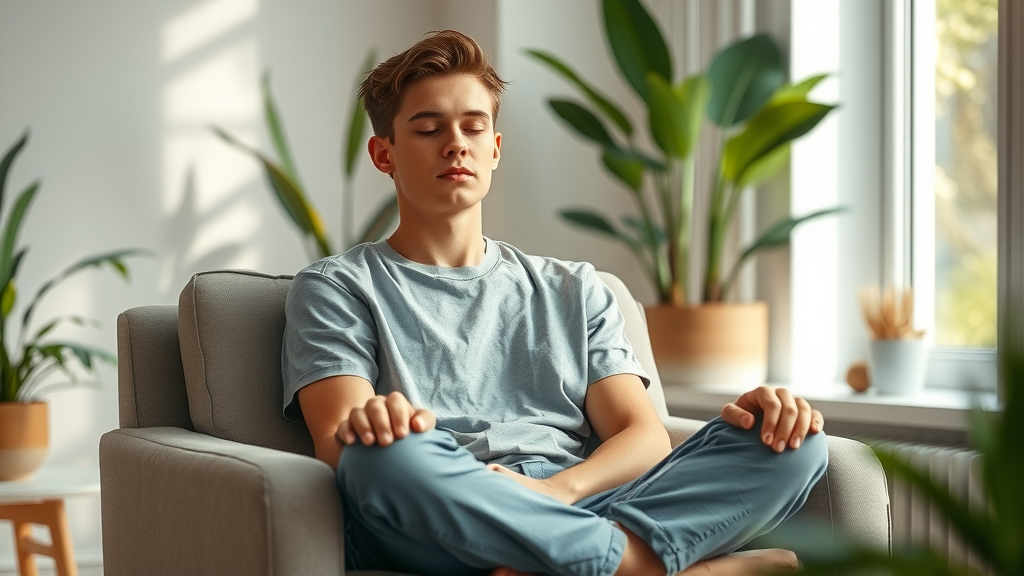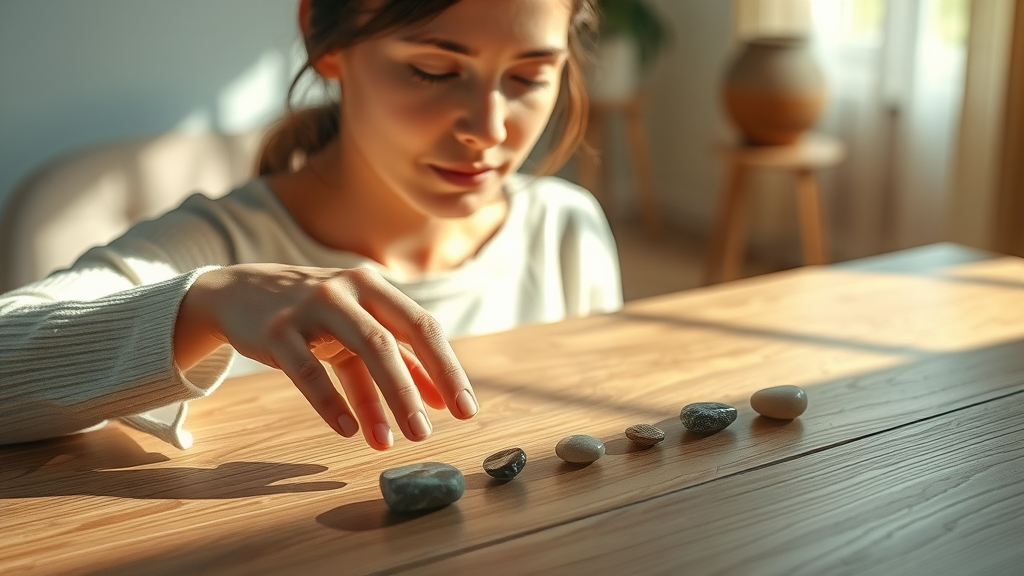Have you ever wondered if it’s truly possible to rewire your mind’s habits and reactions—all by yourself, in the comfort of your home?
Self-hypnosis 101 is rapidly gaining attention for its ability to unlock the power of your subconscious mind, transforming everything from stress to stubborn habits. In this guide, you’ll discover the essentials, practical techniques, science, and real-life applications that can make self-hypnosis a game-changer in your daily life.
Unlocking the Secrets of Self-Hypnosis 101: A Captivating Introduction
The concept of self-hypnosis 101 invites you to explore a fascinating intersection where modern science meets ancient wisdom, promising the tools to nurture your mental health, manage stress, and achieve positive change in a wide range of issues. As you begin your journey, you may ask: What really happens when the brain enters a hypnotic state? The process doesn’t involve swinging pendulums or mysterious rituals—instead, it centers on focused attention, deep relaxation, and the deliberate use of suggestion to influence your thought patterns. Research has shown that self-hypnosis can offer results comparable to guided meditation, targeting stress reduction, habit change, and even performance enhancement.
For beginners, knowing where to start is crucial. Whether your goal is weight loss, breaking unhealthy habits, or managing chronic pain, self-hypnosis offers an accessible, cost-effective approach. The key is to fully understand what self-hypnosis is—and what it isn’t. This guide will unravel the science, outline the core steps, and tackle the myths that might prevent you from experiencing its profound everyday benefits. If you’re curious about mental wellness and personal growth, stick with us as we demystify self-hypnosis 101 with step-by-step guidance, expert insights, and actionable tips you can use right away.

What You'll Learn from Self-Hypnosis 101
The fundamentals of self-hypnosis and its practical uses
Step-by-step instructions for beginners
The science-backed benefits of self-hypnosis
Common myths and realities about self-hypnosis
Safety guidelines and who should avoid self-hypnosis
Understanding Self-Hypnosis 101: Origins and Evolution

Early Practices of Hypnosis and Influence on Self-Hypnosis 101
The journey of self-hypnosis 101 traces its origins back to the early civilizations where rituals, chanting, and trance states were common in traditional Chinese medicine, shamanic practices, and ancient healing arts. Historical accounts reveal that hypnotic states were integral to rituals promoting relaxation and mind-body harmony. These early methods emphasized the connection between mind and body—a holistic approach echoed in modern hypnotherapy.
In the 18th and 19th centuries, figures like Franz Mesmer and later, James Braid, sought to understand these trance-like phenomena through the lens of burgeoning Western science. Their investigations led to the recognition of hypnosis as a psychological treatment that could influence thought patterns, induce a deep state of relaxation, and set the stage for positive change. Many foundational techniques—such as guided imagery and progressive relaxation—are still employed in self-hypnosis today. The wide range of practices throughout history underscores how humanity has long sought to influence the subconscious mind to achieve healing, growth, and transformation.
Modern Science and Self-Hypnosis 101
With advancements in neuroscience, self-hypnosis has shifted from mystical intrigue to a subject of rigorous scientific study. Researchers have used brain imaging to observe changes in brain activity during a hypnotic trance, revealing that the brain enters a state distinct from both wakefulness and sleep. The hypnotic state is marked by focused attention, decreased peripheral awareness, and heightened responsiveness to suggestions—a combination conducive to cementing healthy habits and encouraging mental health breakthroughs.
Research has shown that self-hypnosis can be a valuable tool in addressing a wide range of issues, including stress, weight loss, smoking cessation, chronic pain, and anxiety. Unlike guided meditation, self-hypnosis leverages the power of suggestion directly and can be personalized for individual goals. The scientific evidence supporting self-hypnosis is growing, with peer-reviewed studies highlighting benefits in both clinical and everyday life contexts. The transition from ancient ritual to a modern, accessible self-help method makes self-hypnosis 101 more relevant than ever.
How Self-Hypnosis 101 Works: The Science Behind the State
At its core, self-hypnosis 101 is about harnessing the power of suggestion and accessing the subconscious mind through a structured state of deep relaxation. When you practice self-hypnosis, your brain wave patterns shift, often mirroring those observed in guided meditation or light sleep. This shift allows the conscious mind to temporarily step aside, giving space to plant new thought patterns, reinforce positive change, and address a wide range of issues from stress to chronic pain.
The science behind self-hypnosis 101 reveals that the hypnotic state is neither sleep nor magical mind control—rather, it’s a trance-like concentration where the brain’s activity becomes more receptive to suggestions for positive change. Neuroimaging studies highlight changes in brain wave frequency, blood flow, and overall brain activity during hypnosis, supporting its use for stress management, weight loss, and promoting relaxation. By understanding these mechanisms, you can approach self-hypnosis with realistic expectations, using it as a tool to enhance daily life and mental health.
Comparing States: Self-Hypnosis, Meditation, and Sleep |
|||
Aspect |
Self-Hypnosis |
Meditation |
Sleep |
|---|---|---|---|
Level of Awareness |
Focused attention, subconscious mind engaged |
Varies (mindfulness to deep focus) |
Minimal to none |
Brain Wave Activity |
Theta and alpha waves; similar to guided meditation |
Alpha and theta waves |
Theta and delta waves |
Key Goal |
Implementing positive change, breaking/unforming habits |
Stress relief, awareness, calm |
Bodily and mental restoration |
Responsiveness to Suggestion |
High (power of suggestion at work) |
Low to moderate |
Very low |
Applications |
Wide range of issues: weight loss, pain management, habit formation |
Daily life stress reduction, emotional balance |
Physical & mental recovery |
Practical Guide: The Four Steps of Self-Hypnosis 101
Preparation: Creating a Comfortable Environment

Before starting a self-hypnosis session, it’s essential to prepare a tranquil environment. Choose a quiet, softly lit space—preferably with comfortable seating and minimal distractions. Some find that incorporating elements like a yoga mat, soft cushions, or a cozy blanket enhances comfort and sets an inviting tone. The use of calming scents, such as essential oils or a lit candle, can signal the brain to relax. Preparing not just your physical space but also your mindset is crucial: switch your phone to silent and let others know you’ll need uninterrupted time.
This preparation phase mirrors creating a ritual similar to guided meditation or mindfulness practice. Here, your goal is to set the stage for focused attention and a total state of relaxation. By establishing a comfortable and safe setting, you’re already priming your subconscious mind for a successful session. Remember, the foundation of an effective self-hypnosis 101 practice lies in consistency and a positive, distraction-free environment.
Induction: Entering the Hypnotic State
The induction stage is the bridge between regular awareness and the unique, receptive state of self-hypnosis. Most beginners start with progressive relaxation or guided imagery—methods commonly supported by research for their ability to prompt quick relaxation and a hypnotic trance. Begin by closing your eyes and taking slow, deep breaths. Moving from head to toe, consciously relax each muscle group, letting go of tension with every breath. Visualization—such as imagining a peaceful place or counting back from ten—can further enhance relaxation and guide the brain toward a hypnotic state.
During induction, your brain activity shifts, promoting increased focus and receptivity. This is also where your subconscious mind becomes most open to positive change. The beauty of induction is its adaptability; some prefer listening to a recorded script, while others favor silent self-talk. Consistency in technique, however, ensures the best results over time. As always, be gentle and patient with yourself throughout the process.
Deepening: Enhancing the Hypnotic Experience
Once a basic level of relaxation is reached, the deepening phase cements the trance, boosting your receptiveness to suggestion. Classic deepening techniques include visualizing sinking deeper into comfort (such as descending stairs), slow rhythmic breathing, or repeating phrases like “deeper and deeper.” Counting back, either mentally or with gentle audio cues, is another effective method that signals your subconscious mind you’re ready for meaningful inner work.
This stage is critical for solidifying the hypnotic trance. Brain wave studies confirm that during deepening, the mind transitions further from conscious thought, optimizing your mental and emotional state for lasting transformation. By the end of this phase, many report a profound state of relaxation and focus—crucial for the final step of self-hypnosis 101.
Suggestion: Implementing Positive Change
Suggestion is the heart of self-hypnosis 101—where you use affirmations, visualizations, or intention-setting to foster positive change. Make suggestions simple, positive, and in the present tense (e.g., “I feel calm and confident,” or “I am making healthy choices daily”). This is where the power of suggestion works most effectively, especially against old thought patterns, emotional eating, or unhealthy habits.
Speak your desired outcome gently to your subconscious mind, repeating it several times if needed. Visualization, another core technique, can reinforce your goals—imagine yourself successfully adopting new behaviors or attitudes. After several minutes, gradually reorient yourself, reminding your mind you’re returning to full awareness. Practice makes suggestion more powerful, enabling the brain to accept new patterns over time.
Self-Hypnosis 101 for Beginners: Tips, Tools, and Setting Up
Essential supplies for an effective session
Recommended scripts and resources
Common challenges and how to overcome them

Starting your self-hypnosis 101 journey is easier with the right support. Set yourself up with a comfortable chair or yoga mat, a notebook for reflection, headphones for listening to guided hypnosis tracks, and a soothing essential oil for sensory anchoring. Not only do these essentials increase comfort, but they also reinforce the ritual, signaling your mind it is time for focused relaxation.
Selecting beginner-friendly scripts is also key. Free resources and apps often offer a wide range of guided self-hypnosis sessions, focusing on everything from weight loss and stress reduction to breaking bad habits. Many recommend starting with general relaxation or stress relief scripts before progressing to specific goals. When obstacles arise—such as trouble focusing, persistent mental chatter, or skepticism—it’s helpful to remind yourself that gradual progress is normal. Record your sessions and reflect on them in your notebook to track improvements over time and maintain motivation.
Self-Hypnosis 101 and Weight Loss: Can it Help?
“Self-hypnosis gives the individual more control over their food choices and emotional eating responses.” — Clinical Hypnotherapist

Many turn to self-hypnosis 101 as a complement to weight loss strategies, leveraging its power to influence the subconscious mind and foster healthy habits. Research has shown that when you regularly engage the mind in a hypnotic state, you can disrupt cycles of emotional eating and reinforce mindful food choices. Unlike diets that focus solely on willpower, self-hypnosis addresses the underlying thought patterns and stressors that often sabotage healthy intentions.
Typical self-hypnosis weight loss scripts include affirmations about body confidence, visualizations of healthy meals, or the suggestion of mindful eating habits. Over time, these positive suggestions can reframe your relationship with food, reduce cravings, and encourage consistent healthy choices. While self-hypnosis is not a magic cure, it is a science-based method that, when paired with lifestyle adjustments and a balanced diet, supports sustainable weight loss and improved daily life.
Investigating Self-Hypnosis 101 Myths: Separating Fact from Fiction
List of common misconceptions about the safety and effectiveness of self-hypnosis 101
Clarifications supported by expert opinions and peer-reviewed studies
Misinformation often clouds the understanding of self-hypnosis 101. Common myths include the belief that self-hypnosis is mind control, that only certain people can benefit, or that it is unsafe without a professional. In reality, the hypnotic state achieved in self-hypnosis is a natural form of focused attention—much like being deeply engrossed in a book or movie—and you remain in control the entire time.
Expert opinions and peer-reviewed studies confirm that self-hypnosis does not bypass your ethics or willpower, nor can anyone “get stuck” in a trance. The science suggests that, when practiced as taught, self-hypnosis is as safe as guided meditation, offering benefits for stress, weight loss, and even chronic pain management. The key is informed practice and respect for safety guidelines, ensuring suitability for your individual health.
Who Should Not Practice Self-Hypnosis 101?
People with certain psychiatric disorders
Individuals with a history of psychosis
Children without professional supervision
While self-hypnosis 101 is generally safe for most, certain individuals should avoid the practice or seek professional guidance. Those with unresolved psychiatric disorders (such as dissociative disorders, schizophrenia, or severe depression) may experience an intensification of symptoms or emotional discomfort. Individuals with a history of psychosis should never practice hypnosis without medical supervision. Children and adolescents should only engage in self-hypnosis under the guidance of a qualified therapist or medical professional, ensuring safety and age-appropriate content. When in doubt, consulting a healthcare provider ensures your mental health is protected and your experience is supportive, not harmful.
Safety Guidelines and Precautions for Self-Hypnosis 101
Dos and Don’ts for beginners
When to seek professional guidance
Ensuring your safety during self-hypnosis 101 is critical to a positive experience. Do practice in a comfortable, private space where you won’t be disturbed, especially if you are new to the technique. Don’t attempt self-hypnosis while driving or operating machinery. Always listen to your feelings—if anxiety or fear arises, pause the session and reflect on your readiness. For those with a significant medical condition or psychological treatment history, consulting a licensed mental health or medical professional is strongly recommended.
Applying Self-Hypnosis 101: Everyday Uses and Benefits
Stress reduction and relaxation
Habit formation and breaking
Performance enhancement in academics and sports
Pain management and better sleep

Self-hypnosis 101 brings tangible benefits to various areas of daily life. The most popular use might be stress reduction; sessions designed to calm the mind and body have been shown to trigger the body’s relaxation response, lowering blood pressure and calming anxiety. In the realm of habit formation, self-hypnosis can help break cycles of unhealthy behavior—like smoking cessation or emotional eating—by embedding positive thought patterns in the subconscious mind.
Other proven applications include boosting performance in sports or academics through focused attention and mental rehearsal, a technique commonly used by elite performers. Pain management, especially for chronic pain, is another well-supported use, as self-hypnosis can teach the mind to reinterpret or reduce pain signals. Finally, those with sleep challenges can benefit from scripts targeting restful sleep and relaxation, establishing a healthy sleep pattern over time. By integrating self-hypnosis into your regular self-care routine, you tap into its wide range of evidence-based benefits.
The Rule of 7 in Hypnosis and Its Role in Self-Hypnosis 101

In hypnotherapy, the “Rule of 7” refers to the idea that a suggestion may need to be repeated several times—often up to seven repetitions—for the subconscious mind to fully accept and internalize the new message. This principle matters in self-hypnosis 101, emphasizing consistent, patient practice. Each repetition reinforces the desired belief or behavior, gradually modifying entrenched thought patterns.
If you’re new to self-hypnosis, remember: results may not be immediate. Persistence, backed by the Rule of 7, builds a strong foundation for achieving goals, whether it’s weight loss, breaking unhealthy habits, or managing stress. With regular, patient repetition, you leverage the brain’s capacity for neuroplasticity—making positive change not only possible but sustainable.
Can I Learn Self-Hypnosis 101 on My Own?
Absolutely—most beginners successfully learn self-hypnosis 101 independently. Thanks to accessible books, online courses, and guided audio tracks, this empowering skill no longer requires expensive therapy or private sessions. The most important requirements are motivation, a willingness to learn, and a structured, distraction-free environment. For complex goals or if you encounter persistent barriers, consider a session or two with a certified hypnotherapist, who can tailor scripts and provide specialized guidance.
Your self-hypnosis journey will unfold at your own pace. Take comfort in knowing that, with regular practice and the proper tools, you can nurture your mental health, overcome obstacles, and harness your subconscious mind for practical, daily benefits. Begin with general scripts and progress toward more specific targets for maximum results.
Real Stories: Success with Self-Hypnosis 101
“Practicing self-hypnosis helped me conquer exam anxiety and improve my focus.” — University Student
“With self-hypnosis 101, I made real progress in my weight loss journey.” — Wellness Coach

The power of self-hypnosis 101 is perhaps best highlighted in personal testimonials. Students report conquering test anxiety and boosting academic performance; adults share stories of breaking free from long-standing habits and achieving sustainable weight loss; athletes and professionals celebrate improved focus and resilience under pressure. These real-life experiences demonstrate how, with the right approach and regular practice, self-hypnosis can drive lasting transformation across a wide range of mental health and daily life challenges.
These stories emphasize two recurring themes: the persistent application of positive suggestion, and a commitment to self-guided personal development. As you embark on your own self-hypnosis journey, take inspiration from these successes and remember that your unique goals are entirely within reach.
Top Resources for Deepening Your Understanding of Self-Hypnosis 101
Books, apps, and online courses for further learning
Expanding your self-hypnosis 101 practice is easier than ever, thanks to a broad selection of reputable resources. Popular books like “Trancework” by Michael Yapko and “Self-Hypnosis Revolution” by Forbes Blair provide science-backed techniques and scripts. Apps such as “Hypnobox” and “Relax & Sleep Well” deliver mobile access to expert-authored audio sessions. Over 100 online courses—available via platforms like Udemy or Coursera—cover introductory and advanced methods, supporting a wide range of goals from weight loss to stress reduction. Investing time in these tools will deepen your understanding and help you perfect your personal practice.
Popular Questions About Self-Hypnosis 101: People Also Ask
Can I learn self-hypnosis on my own?
Yes, you can! Most people find self-hypnosis 101 straightforward with a structured approach, basic preparation, and access to beginner-friendly scripts or audio guides. It’s important to approach practice with patience—progress can be gradual, but consistency and a calm environment are the keys to long-term success.
What is the rule of 7 in hypnosis?
The Rule of 7 in hypnosis suggests that a positive suggestion should be repeated seven times for your subconscious mind to fully accept it. This principle helps reinforce thought patterns and increases success in achieving your goal, whether in stress reduction, healthy habits, or breaking unhealthy cycles.
Who should not be hypnotised?
People with active psychiatric disorders, those with a history of psychosis, and children without professional guidance should not engage in self-hypnosis. Always consult a healthcare or mental health professional if unsure about your suitability for self-hypnosis, especially when dealing with a chronic medical condition.
What are the four steps of self-hypnosis?
The core steps are: (1) Preparation—creating a calm, comfortable environment; (2) Induction—using progressive relaxation or guided imagery; (3) Deepening—reinforcing the hypnotic state with further visualizations or counting back; and (4) Suggestion—introducing positive and actionable affirmations to the subconscious mind.
FAQs on Self-Hypnosis 101 for Beginners
How often should I practice self-hypnosis 101?
Most experts recommend practicing 3–5 times per week for noticeable results, but even short daily sessions can be effective.Is self-hypnosis 101 safe for everyone?
Self-hypnosis is safe for most adults, but those with serious mental health conditions or a history of psychosis should seek professional advice before attempting.What are some signs that self-hypnosis 101 is working?
Indicators include a heightened sense of relaxation, improved mood, noticing shifts in thought patterns, and progress toward your goals, such as better sleep or reduced cravings.Can self-hypnosis 101 replace therapy or medication?
Self-hypnosis can complement—but not replace—professional therapy and prescribed medication, particularly for medical or psychological treatment. Always consult your provider for guidance.
Key Takeaways from Self-Hypnosis 101
Self-hypnosis 101 is accessible, safe for most, and effective when practiced regularly
Scientific evidence supports its use in managing stress, habits, and performance
Safety and suitability should always be considered before practicing
Ready to Experience Self-Hypnosis 101? Start Your Journey Today
Self-hypnosis 101 is your gateway to greater self-understanding and personal transformation—empowering you to harness your own mind for lasting positive change. Begin your journey today—a more focused, resilient, and relaxed you awaits.
 Add Row
Add Row  Add
Add 




Write A Comment